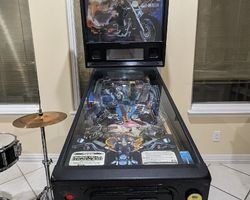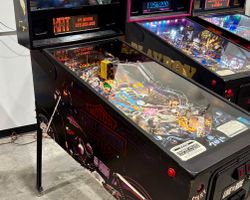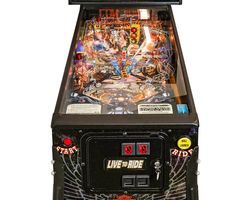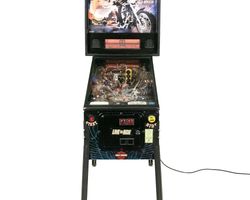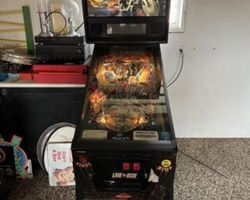Harley-Davidson®
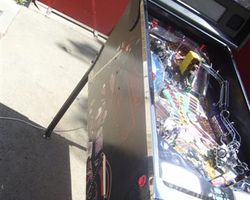
Average Prices: USD $1,700 to $3,900
Produced: September, 1999
Machine Type: Solid State Electronic
Players: 6
The pinball machine "Harley-Davidson," released by Sega Pinball, Incorporated in September 1999, stands as a notable entry in the late 20th-century pinball landscape. Bearing the official license of the iconic motorcycle manufacturer, this game aimed to translate the spirit of the open road and the culture surrounding Harley-Davidson into an interactive arcade experience. It holds a unique position as the final machine produced by Sega Pinball before the company’s pinball assets transitioned to Stern Pinball. Its production continued shortly thereafter under the Stern banner as "Harley-Davidson (1st Edition)," marking a direct lineage between the two manufacturers.
The development of the Sega Harley-Davidson machine involved a collaborative effort from an experienced team. The core design of the playfield was primarily the work of John Borg, a designer known for his distinct layouts. Lonnie D. Ropp contributed significantly to both the design and the software, crafting the ruleset and game logic. The immersive auditory experience was shaped by Kyle Johnson, who composed the music and developed the sound effects, while Kurt Andersen was responsible for the animations displayed on the dot-matrix screen. An interesting piece of trivia connected to the machine is the involvement of Fred Young, who lent his voice characterizations to the Sega version. This confluence of talent aimed to deliver a pinball game that resonated with both pinball players and enthusiasts of the Harley-Davidson brand.
Signature Features and Design
"Harley-Davidson" integrates several standout features designed to capture the essence of its theme and enhance gameplay. Dominating the upper playfield is a unique motorized motorcycle toy. This interactive element performs a wheelie, spitting out balls and serving as a mechanism for ball locking, directly integrating the theme into core gameplay. Beyond this primary feature, two additional miniature motorcycles are positioned on the slingshots, reinforcing the thematic presence across the playfield.
Further contributing to the thematic immersion is a built-in shaker motor. This component is strategically utilized to simulate the rumble and vibration of a motorcycle engine, particularly during high-action sequences like multiball, adding a tactile dimension to the game. A traffic light toy also provides visual cues and thematic flair, often signaling game states or modes. A distinctive mechanical innovation of this machine is the inclusion of a third button on the lockdown bar, independent of the flipper buttons. This button activates a center post, designed to prevent drain outs, adding a unique strategic element to gameplay, though its utility is subject to player preference and skill. The artwork, while aiming to evoke the Harley-Davidson aesthetic, particularly on the cabinet and translite, drew varied opinions within the community, with some later editions under Stern making adjustments to the visual style.
Playfield and Mechanics
John Borg’s playfield design for "Harley-Davidson" prioritizes speed and flow, providing an accessible layout for players of varying skill levels. The playfield is arranged to offer a series of distinct shots that keep the ball moving, contributing to a sense of rapid progression. Central to the action is a prominent, steep swooping ramp, which serves as a primary shot and a key pathway for ball progression.
The layout incorporates dual orbits, allowing for continuous looping shots that can build momentum and score points. A spinner target is positioned within one of these orbits, rewarding precise shots with satisfying whirls and score accumulation. The playfield also features eight drop targets, typically arranged in rows on the sides, which challenge players to hit specific areas for mode progression or point bonuses. Four pop bumpers are strategically placed, contributing to chaotic ball action and unpredictability, while a scoop target offers another specific shot for initiating modes or collecting rewards. The overall design philosophy emphasizes hitting shots quickly and efficiently, with many key targets positioned relatively close to the flippers. The playfield artwork, coupled with the lighting, reinforces the gritty, chrome-laden aesthetic associated with the Harley-Davidson brand, guiding the player’s eye through the various routes and targets.
Gameplay Dynamics
The gameplay dynamics of "Harley-Davidson" are structured to be straightforward, making it approachable for new players while still offering objectives for those seeking higher scores. The ruleset focuses on collecting "patches" from different cities, which serves as the primary progression path toward the wizard mode. This clear objective provides a sense of journey throughout the game.
Multiball is a central and highly praised aspect of the gameplay experience. The machine is capable of supporting up to four-ball multiball, which frequently results in fast-paced, high-energy play. Players often find it relatively easy to initiate multiball and achieve jackpots, leading to exciting scoring opportunities and a feeling of wild action on the playfield. Beyond multiball, the game includes a video mode where players use the flippers to navigate a motorcycle, avoiding pedestrians and cars, adding a distinct mini-game diversion. The scoring system also incorporates a "Bonus X at balls end" mechanic, allowing skilled players to strategize for high bonus multipliers and substantial end-of-ball scores. The unique third button, controlling a pop-up center post, introduces a strategic layer where players can choose to risk a potential drain for a save, or bypass it entirely.
Reception and Legacy
The reception of Sega's "Harley-Davidson" within the pinball community has been notably polarized. Many players lauded its strengths, particularly its fast, flowing gameplay and approachable ruleset, making it a compelling choice for beginners and casual players. The multiball modes frequently received praise for their excitement and plentiful nature, often leading to chaotic and enjoyable action. The main ramp shot was consistently highlighted as satisfying, and the unique interactive motorcycle toy, along with the immersive shaker motor, were often cited as appealing thematic elements. The "Bonus X" scoring system was also recognized for adding depth for those aiming for high scores.
Despite these positive aspects, the machine faced significant criticism, particularly from more seasoned pinball enthusiasts. A recurring complaint revolved around a perceived lack of depth in the ruleset, leading some to describe the game as bland or uninspired for extended play. The execution of the Harley-Davidson theme also drew mixed reactions; while some appreciated the overall aesthetic, others felt it was generic or did not fully capture the brand’s essence, citing specific critiques about the artwork in earlier editions. Audio elements, including the music and call-outs, were sometimes described as repetitive or annoying. Some players also noted a lack of shot variety, with many key shots concentrated too close to the flippers, reducing the challenge of long, difficult shots. The video mode was occasionally criticized for being recycled and offering disproportionately high scores.
"Harley-Davidson" holds a unique place in pinball history as the final machine produced by Sega Pinball, Inc. before its transition to Stern Pinball. Its immediate continuation under the Stern brand underscores its market relevance and the enduring appeal of the licensed theme. While it may not be universally celebrated by every pinball collector due to its perceived simplicity, its accessibility and focus on high-energy multiball action have cemented its reputation as a fun, fast-playing machine that serves as an excellent entry point for new players into the hobby. Its legacy is tied to this duality: a game that might not satisfy every advanced player's demand for complexity, but consistently delivers accessible excitement, ensuring its continued presence in the discussion of popular licensed pinball themes.
Sponsored Links
 Ebay Listings
Ebay Listings
 Auction Results
Auction Results
| Cost | Location | Date |
|---|---|---|
| USD $2,300 |  Maryland, United States Maryland, United States |
04 September, 2025 |
| USD $6,990 |  Tennessee, United States Tennessee, United States |
15 May, 2025 |
| GBP £3,600 |  United Kingdom United Kingdom |
20 January, 2025 |
| USD $2,500 |  Illinois, United States Illinois, United States |
21 April, 2024 |
| USD $2,500 |  Illinois, United States Illinois, United States |
19 April, 2024 |
| USD $2,995 |  United States United States |
27 December, 2023 |
| USD $4,079 |  Ohio, United States Ohio, United States |
11 October, 2023 |
| USD $6,499 |  California, United States California, United States |
03 October, 2023 |
| USD $3,650 |  Illinois, United States Illinois, United States |
14 July, 2023 |
| USD $3,975 |  Indiana, United States Indiana, United States |
04 June, 2023 |


Private Policy · Search Website · Contact Us
As an eBay Partner, we may earn a commission from qualifying purchases made through links on this site, at no additional cost to you.
All trademarks and copyrighted materials remain property of their respective owners. All other content copyright 2007 - 2025 Pinpedia.


